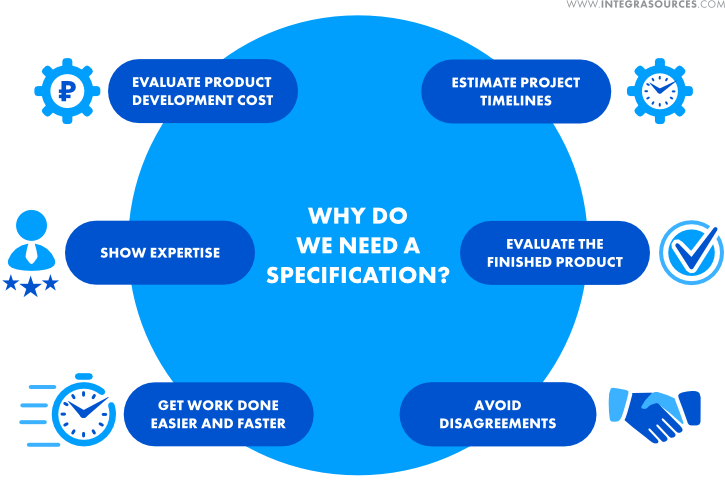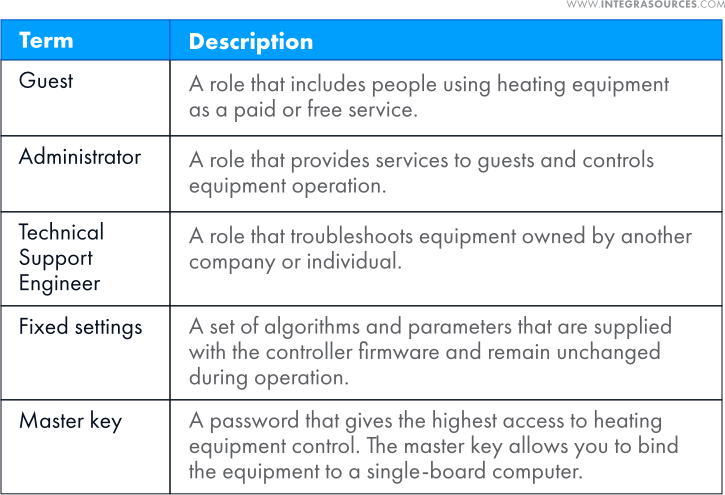This website uses cookies so that we can provide you with the best user experience possible. Cookie information is stored in your browser and performs functions such as recognising you when you return to our website and helping our team to understand which sections of the website you find most interesting and useful.
Project Development Specification: How To Write the Right One


Andrey Solovev
Chief Technology Officer, PhD in Physics and Mathematics

Nina Bibikova
IT Writer, Specializes in Electronics and Software Development Topics
All successful IT products were once just ideas. In most cases, brilliant ideas come from people far from software and hardware development.
It’s great when enthusiasts with thoughts, dreams, and insights want to improve their businesses, as they know their needs very well. But above all, technical specialists should be able to understand ideas correctly and transform them into a working device or a program.
The project development specification helps bring ideas to life in the right way. Why is it crucial to prepare specifications? Who should prepare a spec and how should one be written? Can we do it without the requirements document? How can one avoid overpaying for the development of a requirement document?
You can find all the answers in our article.
Why Do We Need a Specification?

A requirement specification for hardware and software development is a document that defines the requirements for an IT product, including its purpose, functions, behavior, components used, technologies, development tools, and working procedures.
A project dev specification serves as the guide for business and technical teams involved in IT solution creation.
A requirement specification is equally necessary for both the customer and the developer. Being the work of specialists from different fields, a spec is used by the client and contractor throughout the entire development process and after the project is finished.
- A project dev specification for device design or software development allows customers to get preliminary estimates of the product development cost. The cost of sophisticated devices and high-performance apps is hard to estimate offhand. It is necessary to consider a fairly large number of points: labor, components, logistics, certification, and whatnot.A well-written document allows the contractor and the customer to see and evaluate the entire development process and its stages. Thus, the customer will get an idea of the preliminary cost of each work stage. More accurate data is set out in a project estimate.
- A specification indicates an approximate time frame for the project. The client and the outsourcing company will not disagree on terms if each period of the project stage is indicated in the document from the very beginning. Hardware and software development terms can be shifted due to various reasons. Some of them, such as components' waiting times and delivery times, can be foreseen when writing a specification.
- It will be easier for the customer to evaluate the finished solution – an electronic device, application, firmware, or hardware-software system – by comparing it with the description in the requirements specification. That is why the spec should be drawn up competently and as thoroughly as possible.
- A well-written project development specification can say a lot about the competence and experience of the specialists who compiled it. The developers' thoughtful approach to the preparation of the project, as well as clear and comprehensive information given in a spec show the company's service level.
- Joint work can be interrupted or frozen due to certain circumstances: financial and legal constraints, geopolitics, disagreements between business partners, serious logistical problems, etc. With a perfectly crafted specification for IT product development, it is easier for the customer to return to cooperation with the outsourcing company or to find a new one.
- The requirements document describes the product itself, its purpose and functionality, as well as its development stages, electronic components, and software tools to be used. Thus, both the customer and the developer have a thorough understanding of the future IT solution, which serves as insurance against disagreements, misunderstandings, and unplanned changes in the product concept.
Developers’ work gets easier and faster when they rely on a requirements specification. There is no need to spend time coordinating each step with the client.
Can We Do It Without a Spec?
It's not so easy to write project dev specifications. Spec preparation requires time and high qualifications and, naturally, costs money. Therefore, trying to save time and money, the customer may choose to prepare in-house specs or not write any requirement documents at all.
Is it possible to do without technical specifications? Can a client explain what the product should be in simple words, show a sample, or ask to do it by a template?
Any typical project, even a small one, requires a requirements document – a paper that will record all the requirements regarding the product, components, and workflow. This document may not be the project development specification in the classical sense, but you still cannot do without it.
When contacting a custom software and hardware development company, the client can provide a document in which his ideas, wishes, and product vision are presented in any form.
The client's competence in design and programming is a big advantage, but the main thing is to explain the client's wishes for the product as clearly as possible.
Based on this explanation, the developer company will create a full-fledged, high-quality requirements specification that will serve as a guideline in subsequent development.
How to Write a Spec
The technical specification contains subject data and detailed descriptions of the development process. The more difficult the task, the more specialists will be involved in writing the requirements specification, and the more information the finished document will contain.
Who Writes a Requirement Document?

One can't use templates and tips from the Internet to create a good specification.
Requirements documents for device design and software development are written by specialists who know all the process nuances: work stages, terms, components and technologies required, and the final product characteristics. PMs, developers, and testers contribute their data to the document, building an overall project picture.
You can entrust the creation of project development specifications to in-house specialists who know exactly what product you need and can specify the desired functions and characteristics of the device or program in the document.
But this often results in double work, a waste of time and money.
The requirements document created by the outsourcing company takes into account all the client's wishes and the contractor's capabilities (component-specific and language-specific expertise, development experience, etc.).
All points of the technical specifications must be agreed upon by the customer and the developer so that the customer receives a product that meets all requirements.
What Should Be Included in a Project Dev Specification?
Requirements documents are developed for specific projects and, as a rule, are unique. Nevertheless, some points are present in one way or another in all technical specifications for software, hardware, and embedded system development.
Terms, Abbreviations, and Definitions
The terms used in the text are defined at the beginning of the document. These can be IT concepts (element names, development environments, programming languages, and technical definitions), as well as words and designations from the area for which the IT solution is intended.
The more carefully the list of professional words is thought out, the better the contractor and the customer will understand each other.

Product Summary
This block describes the purpose of the IT solution, the reasons for its creation, and the target audience.
Businesses often want to develop an IT product to increase their client base, create a positive image of the company, increase labor productivity, decrease manual labor, etc.
This paragraph also contains information about the objectives of the project: it can be developing a turnkey solution, participating in a separate stage (for example, working on software for a finished hardware platform), or improving an existing product.
Goals must be specific and clear so that the final product meets the requirements and is helpful to the customer.
Project Requirements
The requirements for the project are the basis of the specification and its most significant and detailed part.
Typically, this block contains the following subsections:
General requirements define the phases of the development process.
Here is an example of general requirements for developing a hardware and software system for equipment control.
Project stages:
- To develop a controller to manage client devices.
The controller must be installed on each device.
- To create a device control panel using a Linux-based single-board computer.
- To develop an application for remote control.
- To integrate the control panel and controller into a single system.
- To test the system.
- Subsequent system improvements and modifications
Functional requirements refer to the IT solution's functions and behavior.
Example:
- The system should send notifications about equipment failures.
- The system must control the sensors.
- The system must transmit data over a radio channel.
- The system must have an alarm.
- The system must manage all the device functions.
Non-functional requirements define performance, scalability, maintainability, product security, and other criteria.
Requirements for the development process can be presented in several paragraphs and describe work stages, components, and software tools to be used.
For example, in a project dev specification for a software and hardware complex, you may need a paragraph describing the requirements for the device, communication protocols (MQTT, TCP, etc.), and a user application for managing the device.
The statement of organization and quality of work determines how to arrange everything related to the project: communication between the customer and the contractor, the main points regarding the quality of the system, device, or software product (continuous operation time, system behavior in an emergency, and whatnot).
Security issues may contain requirements for code protection, access control, access rights, etc.
In addition to the main points, the spec contains blocks that are individual for each project, for example, roles for access control, interface requirements, and requirements for the device size and appearance.
What Is a Good Project Development Specification?
What should a quality specification for hardware and software development look like? How many pages do you need – one or fifty? Should you use formal language or technical slang? Do you need pictures or not?
First, the project development specification should be written in clear and simple language, as it will be studied not only by technical specialists but also by sales managers and the customer's team. Of course, you can’t do without technical terms, but you shouldn’t overload the text with them either.
Schemes, drawings, and tables are not compulsory but highly desirable. Graphic elements convey information visually, which many find more comprehensible.
The spec size depends on the project's scale and complexity. The larger the project, the more preparatory documents are needed. The requirements specification for a battery management system, a project that will take several years, cannot be a one-page document.
However, it is necessary to strive for a balance of conciseness, clarity, and informativity even when writing technical specifications for large-scale projects.
What can go wrong if you don’t pay due attention to specification preparation and study? At the very least, it will cost additional time. At worst, it can cause disagreements between the parties and lead to a product that does not meet the customer's requirements.
We faced such situations. Our customer came up with an idea for a device. But some of its functions could not be implemented together. In the specification document, we described the only possible solution, but, unfortunately, the client didn’t pay attention to it. Needless to say, the result unpleasantly surprised him.
To avoid such consequences, the customer should devote time to study the specification: discuss details and delve into the finished document.
It is better to entrust the preparation of technical specifications to professionals – those who will undertake IT solution creation. It doesn't matter if you don't have a clear understanding of the development process, you can just come to them with an idea.
A competent outsourcing team that deals with custom electronics design and software development can draw up a high-quality specification, discuss all the details with the customer, consider all wishes, and select the most appropriate element base and software tools.
A good spec will save time, money, and nerves for both the client and the developer.
Typical Mistakes in Specifications
It's crucial to avoid common mistakes when drawing up a requirements document. Let's take a close look at some slips.
No glossary
What it was: The virtual assistant provides voice interaction, MX Player, Spotify, TuneIn, Audible, Pandora, Hungama, and Ganna playback, and information about EPL, MLB, NBA, NHL, etc.
What it should be: The virtual assistant provides voice interaction, music playback (MX Player, Spotify, TuneIn, Audible, Pandora, Hungama, and Ganna), and information about sports events (EPL, MLB, NBA, NHL, etc.).
Music services: MX Player, Spotify, TuneIn, Audible, Pandora, Hungama, Ganna.
Abbreviations of sports organizations:
EPL: English Premier League
MLB: Major League Baseball
NBA: National Basketball Association
NHL: National Hockey League
Unclear wording
What it was: Since its introduction in 1983, MIDI has developed into a mature standard with a wide range of products and applications. It is a standard that specifies both the hardware connection needed to share the data physically as well as the data protocol for exchanging musical control information.
What it should be: The MIDI (Musical Instrument Digital Interface) format allows you to standardize musical equipment from different manufacturers.
The protocol provides digital data transfer between devices, music playback, and control of auxiliary equipment (pyrotechnics, lighting, etc.).
Too detailed description
What it was: The GS Format is a set of guidelines created by Roland to standardize the performance of sound-generating equipment. It supports all features listed in the General MIDI System. Additionally, the highly compatible GS Format gives a greater variety of sounds, allows for sound editing, and specifies numerous specifics for a wide range of supplementary features, such as chorus and reverberation effects.
The GS Format was created with the future in mind, making it simple to add additional sounds and support new hardware features as they become available. It may be retrofitted to work with the General MIDI System. As a result, Roland's GS Format can faithfully play back GM Scores just as well as GS Music Data (music data written using the GS Format).
What it should be: The GS format is Roland's extension to the General MIDI standard to unify audio equipment characteristics. It supports all the features listed in the General MIDI System, supplementing the standard with new instruments, effects, and functions.
Mixing functional and non-functional requirements
What it was: The system must maintain the water temperature in the heating tank at no higher than 50°C.
What it should be: Functional requirements: the system must maintain a user-defined water temperature.
Non-functional requirements: the water temperature in the heating equipment must not exceed 50°C.
Conclusion
The development of an IT solution – an electronic device, application, embedded software, or IoT system – is preceded by writing a project requirements specification. A spec can be a short document or a lengthy detailed one depending on the project's scale and complexity.
A specification gives an idea of the purpose and functions of the product, the requirements for its development, the stages of work, and the procedure for accepting the completed solution.
The requirements document is the result of the teamwork of the project manager, developers, testers, and, of course, the customer.
As writing technical specifications is a complex process, it requires deep knowledge and expertise in software and hardware development. People who prepare specifications should be able to navigate the electronic components market, evaluate logistics routes, and present information.
The best decision would be to entrust the requirements specification preparation to the outsourcing development company. The crew will take into account its expertise and all the customer's wishes. In this case, product development will go faster and more comfortably.
You can apply to Integra Sources with your idea, and we will help you create a unique application, electronic device, or software and hardware system of any complexity. We will prepare a concise and understandable requirements specification, which will serve as the basis for further cooperation.
Share this article


Related
materials


Corporate Messenger Development
Integra Sources developed a corporate messenger for a large enterprise. The team created a client-server app, a Rest API, and...
LEARN MORE
LEARN MORE

IT Project Discovery Phase: What's That, and What Does It Do?
The project Discovery Phase is aimed at helping you arrange a flawless development process that will provide you with suitable...
LEARN MORE
LEARN MORE

What Makes Electronics Prototyping so Important for Successful Product Development?
Electronics prototyping answers a range of crucial questions, such as how to solve a particular engineering problem, how to do...
LEARN MORE
LEARN MORE

